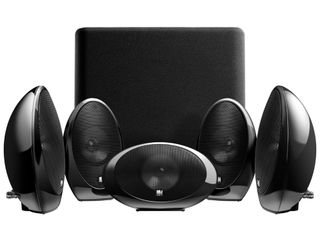New speaker system brings KEF quality home
KHT1005.2 5.1 home cinema system means more for your money

KEF has launched the second generation of its much-vaunted Home Theatre 1000 Series. The KHT1005.2 is an entry-level 5.1 speaker system that shares the same iconic 'egg' design and solid aluminium construction of other models in the KEF range.
The new system is designed to appeal to discerning home theatre enthusiasts looking to get a bit more for their money. As Gary Mardell, UK marketing manager at KEF, explains: "In a world of plastic, the aluminium build quality of this system is second to none."
Sub-woofer packs a punch
The full system comprises of four satellites, one front speaker and a sub-woofer. The main difference between the KHT1005.2 and its predecessor is that the sub-woofer has been changed. At under one cubed foot in size, the new woofer is physically smaller, yet delivers more of a punch.
The 100W analogue amp used in the first incarnation has been replaced with a 150W digital amp for the second-generation.
The four satellites and the centre channel speaker are all based on closed-box design and incorporate KEF's proprietary UNI-Q design. This positions high-frequency audio at the acoustic centre of the mid and low frequencies, so that it effectively works as a point source. The advantage of this, according to Gary Mardell is that "there is a wider sweet spot, so that more people can have more fun".
The KEF KHT1005.2 is available in a choice of two finishes - matt silver and a new high-gloss black paint. There is also the option to wall-mount the satellites, or set them on stands.
Get daily insight, inspiration and deals in your inbox
Get the hottest deals available in your inbox plus news, reviews, opinion, analysis and more from the TechRadar team.
Tech.co.uk was the former name of TechRadar.com. Its staff were at the forefront of the digital publishing revolution, and spearheaded the move to bring consumer technology journalism to its natural home – online. Many of the current TechRadar staff started life a Tech.co.uk staff writer, covering everything from the emerging smartphone market to the evolving market of personal computers. Think of it as the building blocks of the TechRadar you love today.
